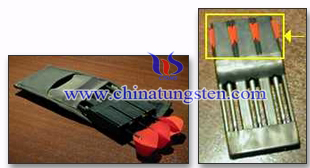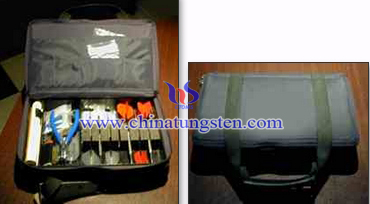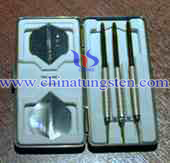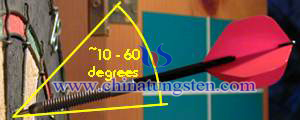Tungsten Darts Cases
- Details
- Category: Tungsten Information
- Published on Thursday, 30 July 2015 18:11
- Written by yingying
- Hits: 346
Sometime we need to take our tungsten darts outside, but how to make it safe and sound to the destination? There are several tungsten darts cases you can choose.
Tungsten dart cases you can of course carry your darts in your trouser pocket, but that's pretty poor treatment, especially for the flights. Remember from the flight section that you should always spread your flights! Your trouser pocket hardly guarantees that. You should really invest in a dart case here, it's worth the bucks. Best choice is a case where you can keep the darts with the flights in proper shape.

This is a very handy case for your darts. Fast access and the flights stay well in shape. Not the cheapest solution, but the most practical.

That's the ultimate dart case, if money is out of question of course!

Not the best solution 'cause the flights must be flattened to store the darts.

The ultimate low-budget case. You often get it with the set of darts you have bought. This is not very useful because again the flights must be flattened and pressed back to shape for action.
Tungsten Dart Manufacturer & Supplier: Chinatungsten Online - http://www.chinadart.com/
Tel.: 86 592 5129696; Fax: 86 592 5129797
Email: sales@chinatungsten.com
Tungsten & Molybdenum Information Bank: http://i.chinatungsten.com
Tungsten News & Tungsten Prices, 3G Version: http://3g.chinatungsten.com
Molybdenum News & Molybdenum Price: http://news.molybdenum.com.cn
Tungsten Darts Tuning
- Details
- Category: Tungsten Information
- Published on Thursday, 30 July 2015 18:02
- Written by yingying
- Hits: 366
Tungsten darts tuning is meant to determine a setup for your tungsten darts that fits your throw. When talking about setup means the flight/shaft system of the tungsten dart. This system is responsible for the aerodynamic behavior of your tungsten darts. It must meet the requirements of darts physics. The main parameter for determining the correct flight/shaft system for you is the angle at which the dart sticks in the board. Unfortunately you can only see this angle when you are playing on a steel tip board. If you are playing only soft tip then you should switch to a steel board for tungsten darts tuning.
Correct dartboard angle
The correct angle is within 10 to 60 degrees. Just like in the picture below. The more consistent this angle is, the better. For instance, if every dart of your 3 dart series sticks in a different angle then something is wrong. Most likely does your dart wobble considerably, which can only be reduced by serious practicing. However, using a bigger flight shape will also help here as it adds stability.
Generally, bigger flights ("standard" shape or bigger) will give a greater angle, while smaller flights (such as "pear" shape) will give smaller angles. Note that when you are doing darts tuning always use the same shaft for comparison between flight shapes. Shaft length and shaft material have a strong effect on the flight/shaft system.
Also note that shaft weight (or even flight weight!) also have influence on this angle. The heavier the shaft or flight is, the smaller the angle will be. This is important when you decide whether you will use nylon or the heavier aluminum or titan shafts. The shaft rings can also influence this, as they make the shaft heavier.
Tungsten darts tuning needs work and patience. It should be done over a couple of days to eliminate possible daily variances in your throw. A good starting setup for tungsten darts tuning is middle length nylon shafts with "standard" size flights. From this initial setup you can continue working, depending on whether your angle is too big or too small.

Tungsten Dart Manufacturer & Supplier: Chinatungsten Online - http://www.chinadart.com/
Tel.: 86 592 5129696; Fax: 86 592 5129797
Email: sales@chinatungsten.com
Tungsten & Molybdenum Information Bank: http://i.chinatungsten.com
Tungsten News & Tungsten Prices, 3G Version: http://3g.chinatungsten.com
Molybdenum News & Molybdenum Price: http://news.molybdenum.com.cn
Spherical and Conical Tungsten Carbide Button
- Details
- Category: Tungsten Information
- Published on Thursday, 30 July 2015 17:55
- Written by xiaobin
- Hits: 326
Comparing with other similar products tungsten carbide button is more suitable for using in high pressure and speed drilling because of its good wearing resistance. According to relevant data, tungsten carbide button drill bits have 4~5 times longer lifespan than other drill bits have same diameter such as split, cross and treble, etc, which not only saves working hours and labor force, but also accelerate the project.
Spherical and conical tungsten carbide button is the most common types. There is a hole on the bottom of spherical button for inlay system impact class drill, drill bits and DTH conical drill bits for very hard rocks. Conical button has similar structure, except taper and chamfer has some differences. Conical button is suitable for medium hard rock formations because conical button is broken easily. In addition, the allowable deviation of arc radius is between 0-0.50mm, chamfer tolerance is ±0.20mm-±0.40mm.
Tungsten Carbide Manufacturer & Supplier: Chinatungsten Online - http://www.tungsten-carbide.com.cn
Tel.: 86 592 5129696; Fax: 86 592 5129797
Email: sales@chinatungsten.com
Tungsten & Molybdenum Information Bank: http://i.chinatungsten.com
Tungsten News & Tungsten Prices, 3G Version: http://3g.chinatungsten.com
Molybdenum News & Molybdenum Price: http://news.molybdenum.com.cn
How Professional Players Grip Tungsten Darts?
- Details
- Category: Tungsten Information
- Published on Thursday, 30 July 2015 17:58
- Written by yingying
- Hits: 309
It seems that professional players always won tungsten dart games easily, it has some secret of success to their gripping of the tungsten darts. Now let’s share how professional players grip tungsten darts.
Pencil - Phil Taylor: Phil holds the tungsten dart in the common pencil-grip. This grip is as good or as bad as any other one, as long as you can keep the tungsten dart pointing forward and not too much sideways. The pencil grip is the second most used after the lot of basic grip variations. It usually requires a thin cylindrical barrel, like used by Phil.
Wide open hand - Dennis Priestley: Dennis used to keep his fingers in a nearly vertical shape and does all the required stabilization only by his thumb. He closed the hand a bit more when I last saw him a video, but he is still the one with the most open hand I know. The grip looks very loose, a good advantage when it comes to exact release, but also a good chance to lose control in accelerating. How he maintains his touch with this grip is a complete miracle to me and seems to be only known by him. When I tried this grip I actually had problems hitting the board. He is either naturally gifted with it, or he has worked on it for years. A grip on the extreme side. Dennis uses a thicker more ton shaped barrel, somewhere between Phil Taylor and John Lowe.
Small finger on the tip - Eric Bristow: Eric in his brilliant years used to keep his small finger wide away from the others, touching the tip of the tungsten dart. Long cylindric barrel. His grip is one variation of the basic grip, not the best, not the worst. Less talented players might struggle with it.
Three fingers - John Lowe: John uses a ton shaped rather thick and short dart, so the 3 finger grip develops natural because more fingers hardly find the space to touch the barrel. Should be considered as a standard grip for this kind of tungsten darts.
Small finger spread away - Rod Harrington: Rod uses a long and thin barrel as it becomes usual more and more when standards and accuracy of the game improve. He uses the basic grip and spreads his small finger away vertically, while the others touch the barrel.
Holding the tungsten dart on the front end - Bob Anderson: Bob holds the tungsten dart way before the center of gravity, just a bit behind the tip. This is unusual, as most players will struggle to develop a good touch for the throw when doing this. Bob 'pulls' the dart more than he throws it. His overall throw is faster than most others and it actually seems as if he permanently is in a hurry. Lots of wrist action. He uses a pencil derived grip which seems logic with this extreme technique, and a pretty long cylindric barrel. Not the grip to recommend, but a sophisticated technique for a man who throws a very dynamic dart.
Tungsten Dart Manufacturer & Supplier: Chinatungsten Online - http://www.chinadart.com/
Tel.: 86 592 5129696; Fax: 86 592 5129797
Email: sales@chinatungsten.com
Tungsten & Molybdenum Information Bank: http://i.chinatungsten.com
Tungsten News & Tungsten Prices, 3G Version: http://3g.chinatungsten.com
Molybdenum News & Molybdenum Price: http://news.molybdenum.com.cn
How to Grip Tungsten Darts
- Details
- Category: Tungsten Information
- Published on Thursday, 30 July 2015 17:55
- Written by yingying
- Hits: 354
The grip is the most variable part of darting technique. In general you can use here what's comfortable for you. But how to grip tungsten darts? There are a few things you has to be aware of.
The basic grip:
Put the dart in your open palm. Balance it and find the center of gravity. Now with your thumb roll the dart to your finger tips. Place your thumb a bit behind the center of gravity, hold it with as much fingers as you like, then move your arm to aiming position. Ready.
Most grips are only slight variations of this standard grip.
Basic requirements:
Point up! Your grip's main objective must be to keep the tip of your dart pointing up in every throwing phase. If yours doesn't meet this, change it immediately.
Solid but not tensed. The grip must be firm, but it must not strain your finger muscles. If your fingers get white from pressure or the knurling digs into your fingertips, this is too much. If your muscles are that strained you have problems in release and all along the throw, this is too much. Darts is a game of touch, not force. To maintain your touch hold the dart loose enough it doesn't slip away, but hold it firm enough to keep control when accelerating. Typical error is rather holding the dart too firm than too loose.
How many fingers? An often asked question, and it can't be answered in general. At least 3 fingers (thumb + 2), maximum all 5. All fingers should touch the barrel or the point, no finger shall touch the shaft or even the flight. A 2 finger (thumb +1) grip gives not enough control, so 3 at least. More fingers give more control in acceleration and more touch, but it makes the release more difficult as more fingers have to be coordinated. Finger coordination in release is a key point for a grip. You have to make sure that no finger can give the dart an unlucky 'kick' in release to slip it out of position at the last moment. This leads directly to the next point:
Barrel shape: Not all kinds of grips are usable on different kinds of barrels. So it's obvious that longer barrels force a more finger grip, while less fingers must be used for short barrels (well, that's just simple-minded reasoning). Not only do you have to find your right grip, you also have to find your right barrel. These things can of course only be seen combined, and reversely.
No fist! What to do with fingers not involved in the grip? The best is to spread them away, or keep them in the same position as the other fingers. It's bad e.g. if you hold the dart with 4 fingers (thumb + 3) and the small finger touches the palm like when making a fist. What happens is that the other fingers will suffer from muscle strain and will tend to a fist more than to the open hand required for a nice release. This will improve the chance of the unlucky finger 'kick' mentioned above, and it also tends to pointing the dart downwards, which we have already discovered as very bad.
To illustrate the wide variaty of grips, some examples from the pros. Note that the grip, as written above, also partly results from the preferred barrel shape, and vice versa.
Tungsten Dart Manufacturer & Supplier: Chinatungsten Online - http://www.chinadart.com/
Tel.: 86 592 5129696; Fax: 86 592 5129797
Email: sales@chinatungsten.com
Tungsten & Molybdenum Information Bank: http://i.chinatungsten.com
Tungsten News & Tungsten Prices, 3G Version: http://3g.chinatungsten.com
Molybdenum News & Molybdenum Price: http://news.molybdenum.com.cn





 sales@chinatungsten.com
sales@chinatungsten.com